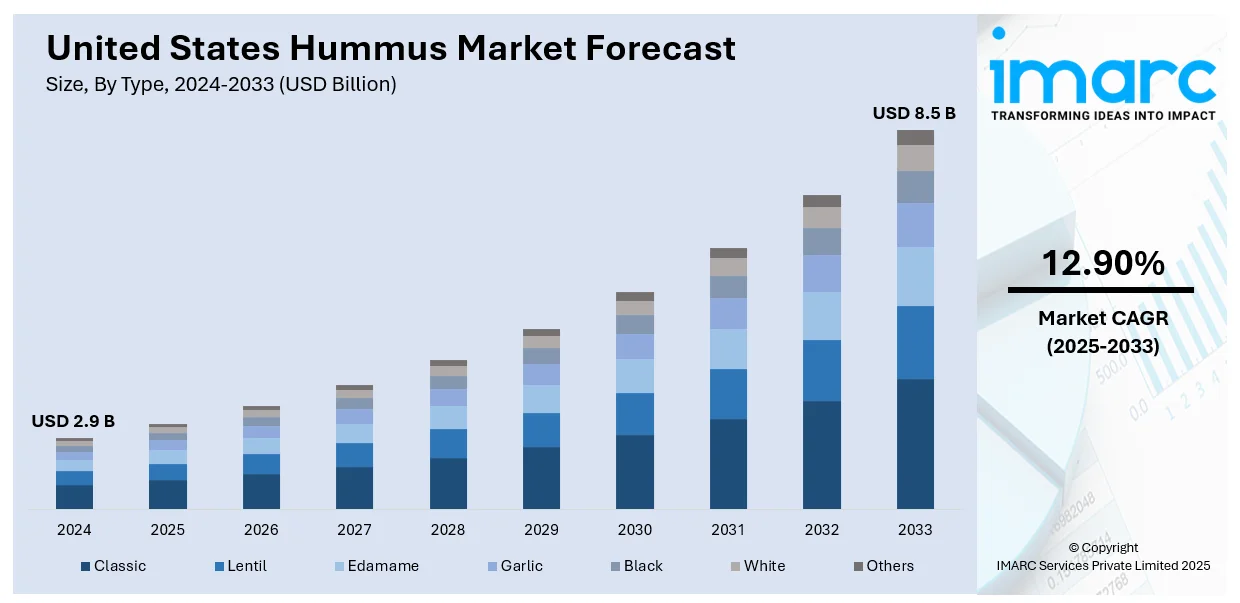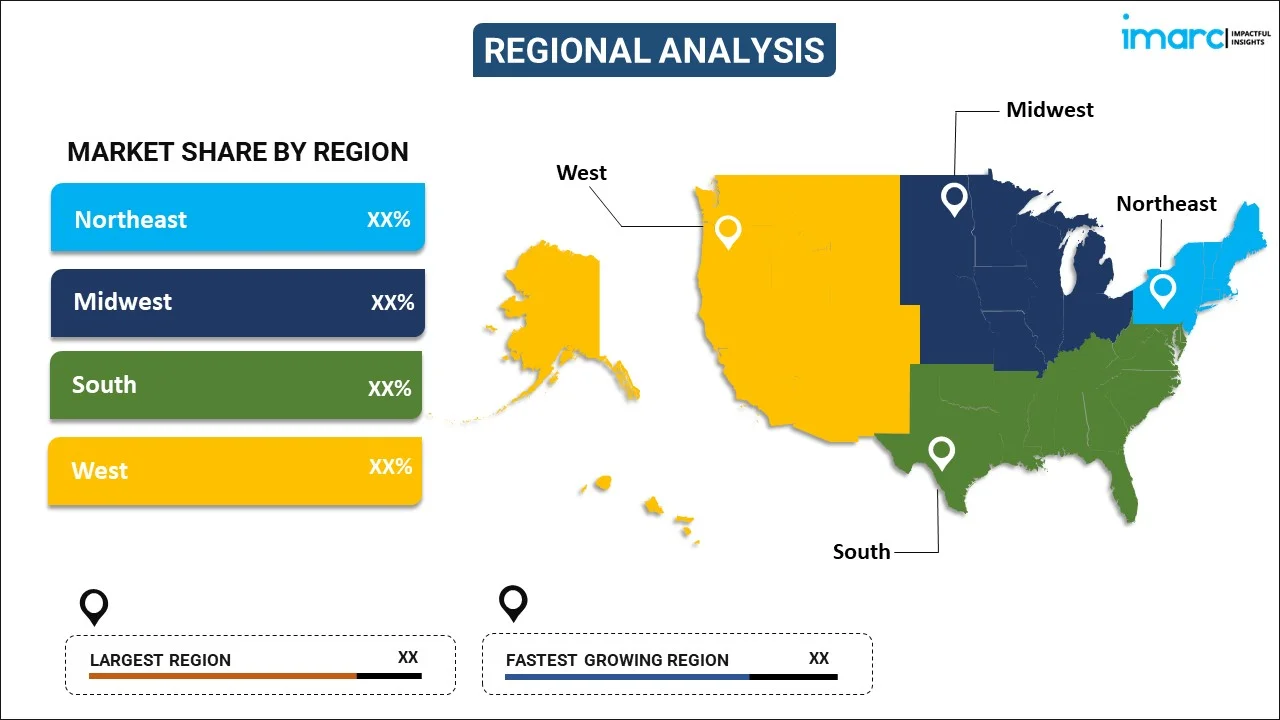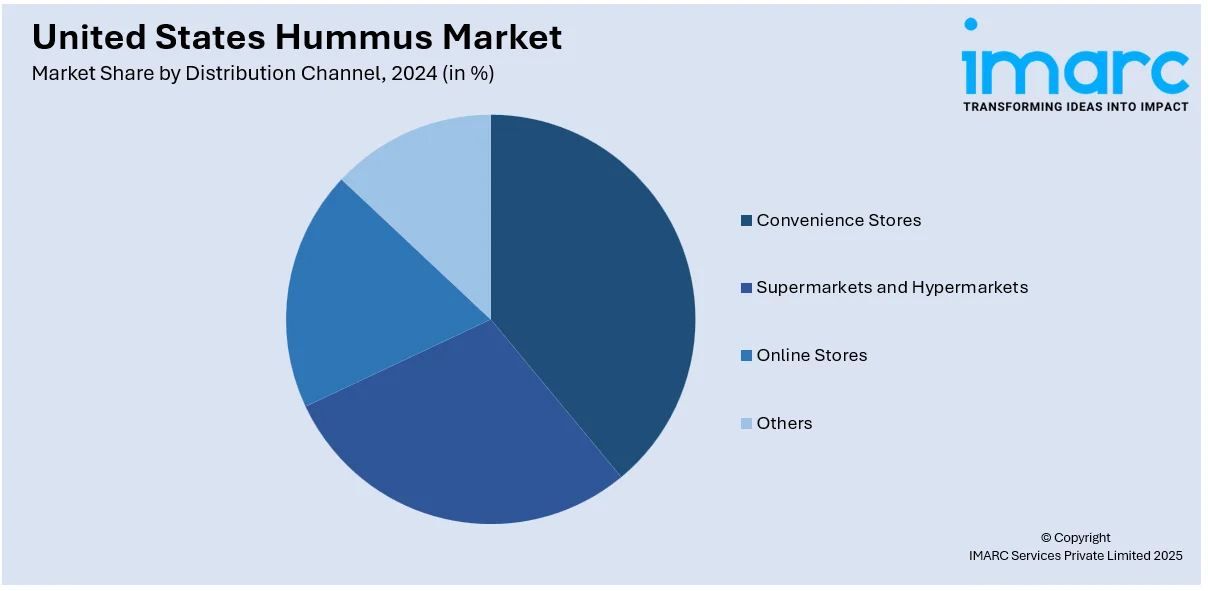
United States Hummus Market Size, Share, Trends and Forecast by Type, Packaging Type, Distribution Channel, and Region, 2025-2033
United States Hummus Market Size and Share:
The United States hummus market size was valued at USD 2.9 Billion in 2024. Looking forward, IMARC Group estimates the market to reach USD 8.5 Billion by 2033, exhibiting a CAGR of 12.90% from 2025-2033. The market is experiencing robust growth, driven by increasing consumer demand for plant-based and nutritious snacks, emerging innovations in flavor offerings, expanding retail and e-commerce distribution channels, rising focus on sustainability and allergen-free options, and the growing popularity of the Mediterranean diet and convenient, on-the-go packaging solutions.
|
Report Attribute
|
Key Statistics
|
|---|---|
|
Base Year
|
2024 |
|
Forecast Years
|
2025-2033
|
|
Historical Years
|
2019-2024
|
| Market Size in 2024 | USD 2.9 Billion |
| Market Forecast in 2033 | USD 8.5 Billion |
| Market Growth Rate (2025-2033) | 12.90% |
The United States market is driven by the rising health campaigns promoting legumes as vital for a balanced diet. Organizations advocating for healthier eating habits are increasing hummus consumption. Additionally, the emphasis on functional foods that provide extra health benefits is inspiring innovations in hummus, with brands adding ingredients like probiotics and superfoods to attract health-focused customers. Moreover, consumer preference for eco-friendly products is driving growth in the hummus market. Brands are adopting sustainable practices like green packaging and clear sourcing to satisfy environmentally conscious consumers. On August 20, 2024, Lantana Foods rebranded its distinct hummus line, unveiling updated designs and sustainable packaging. The initiative reflects the company’s dedication to innovation and environmental responsibility, ensuring its bold and unconventional hummus varieties continue to resonate with environmentally conscious consumers seeking unique flavor experiences.

In addition, fast urbanization and more dual-income families drive the demand for convenience ready-to-eat food items, with hummus on the top due to its flexibility and ease of use. Fine dining restaurants, casual eating spots, are increasingly including hummus in their menus for such demand. These changes among U.S. consumers have made hummus an important part of modern diets of Americans. The expansion of product lines by food manufacturers is also propelling the hummus market. Companies are using acquisitions and innovations across categories to meet changing consumer demands for variety and quality. Lakeview farms announced its acquisition of Noosa Yoghurt, expanding its yogurt portfolio. While the acquisition focuses on dairy products, Lakeview farms continue to innovate across categories, including its popular hummus offerings, to meet diverse consumer demands in the food industry.
United States Hummus Market Trends:
Increasing Consumer Demand for Plant-Based Snacks
The growing preference for healthier, plant-based snacks is driving the hummus and plant-based dips market. As more individuals recognize the nutritional benefits and choose sustainable foods, the demand for innovative plant-based products is rising. Companies are expanding their offerings to provide a variety of flavorful options that align with changing consumer tastes. Strategic investments and acquisitions in this sector enhance product availability and distribution. For instance, on November 22, 2024, PepsiCo announced its acquisition of full ownership of Sabra and Obela, leading brands in the hummus and plant-based dips market. The move aims to enhance PepsiCo's global portfolio of healthier snack options and strengthen its position in the fast-growing plant-based food industry. This trend underscores the importance of plant-based snacks in addressing modern dietary preferences and lifestyle needs.
Growing Consumer Preference for Bold and Unique Flavors
Consumers are looking for exciting taste experiences, prompting manufacturers to create creative flavor blends. This trend is driven by the popularity of globally inspired, spicy, and tangy options appealing to varied tastes. Introducing innovative products not only satisfies consumer demand but also attracts new customer groups. As flavor innovation transforms the market, brands focusing on unique offerings are poised to thrive amidst evolving consumer preferences for distinctive flavors. For example, On October 15, 2024, summer fresh unveiled three new products, including Scorching Dill Pickle Hummus, Honey Jalapeño Hummus, and Spicy Black Bean Dip. This launch reflects the company's commitment to expanding its innovative hummus and dip offerings, catering to evolving consumer tastes for bold and unique flavor profiles.
Expanding Retail and Distribution Channels
Greater accessibility in stores and online channels is significantly fueling growth in the market of hummus in the United States. Supermarkets, specialty stores, and convenience stores have increased their hummus selection to provide customers with several alternatives based on preferences in terms of taste and diet. Retailers that sell online, whether it is through a huge e-commerce platform or a particular brand's website, increase accessibility through convenient delivery options. Direct-to-consumer channels allow the new and relatively smaller brands to tap into a niche market easily. Furthermore, strategic positioning in stores, like the grab-and-go section, boosts product presence and sales. Changes in package size, to single serve and family sizes help consumers stay fresh while ensuring convenience for changing lifestyles.
United States Hummus Industry Segmentation:
IMARC Group provides an analysis of the key trends in each segment of the United States hummus market, along with forecasts at the country and regional levels from 2025-2033. The market has been categorized based on type, packaging type, and distribution channel.
Analysis by Type:
- Classic
- Lentil
- Edamame
- Garlic
- Black
- White
- Others
Classic hummus is a key player in the U.S. hummus market, driving its growth and popularity. Prepared from chickpeas, tahini, olive oil, and garlic, the traditional recipe attracts consumers looking for authentic Middle Eastern flavors. This timeless option is known for its simplicity, versatility, and nutritional benefits, making it a household and foodservice favorite. Its steady demand emphasizes its essential role in market stability.
Lentil hummus is gaining popularity in the U.S. due to its nutritional benefits and unique flavor. Crafted from protein-rich lentils, this type caters to health-focused consumers who want an alternative to classic chickpea hummus. It provides new taste experiences while maintaining the familiar creamy texture. Lentil hummus aligns with dietary preferences such as high-protein and plant-based diets, establishing it as an innovative and expanding segment of the market.
Edamame hummus is a niche but fast-growing segment in the U.S. hummus market. Capitalizing on the popularity of edamame in Asian cuisine, this variety offers a fresh, slightly nutty flavor that attracts adventurous eaters. With high protein and fiber content, along with its vibrant green color, edamame hummus appeals to health-oriented consumers. It is especially favored in areas embracing global food trends, contributing to the diversity and innovation in the hummus market.
Analysis by Packaging Type:
- Tubs/Cups
- Jars/Bottles
- Others
Tubs and cups lead the U.S. hummus market as the top packaging choice. These containers cater to both family sizes and single servings, meeting diverse consumer demands. Their convenience, resealability, and freshness preservation make them popular among households and snackers on the go. Single-serve cups especially meet the rising demand for portion-controlled, portable snacks, making tubs and cups crucial for market growth and accessibility.
Jars and bottles occupy a smaller yet notable segment of the U.S. hummus market, providing unique benefits through durability and premium looks. These packages are favored for specialty and gourmet hummus, appealing to consumers who seek elevated, eco-friendly options. Glass jars resonate with environmentally aware shoppers due to their recyclability. Moreover, the upscale design of jars and bottles propels shelf appeal, showcasing hummus as a sophisticated and versatile food choice.
Analysis by Distribution Channel:
- Convenience Stores
- Supermarkets and Hypermarkets
- Online Stores
- Others
Convenience stores are crucial in the U.S. hummus market, providing quick snack options for busy consumers. Their convenient locations cater to impulse buying and on-the-go lifestyles. Single-serve hummus cups and portable packaging are particularly favored, meeting the demand for nutritious, ready-to-eat foods. By ensuring hummus is accessible, convenience stores help expand its audience, including urban residents and commuters.
Supermarkets and hypermarkets are the main distribution channels for hummus in the U.S., serving as the primary shopping destination for most consumers. Their ample shelf space allows for a wide selection of hummus, from traditional to unique flavors and sizes. These stores also address various dietary needs by offering gluten-free, organic, and plant-based options. Promotions, in-store tastings, and discounts boost customer involvement, reinforcing their role in the growth of the hummus market.
Online retailers are quickly becoming significant in the U.S. hummus market, providing unmatched convenience. E-commerce platforms let consumers browse multiple brands and flavors from home. Subscription services and same-day delivery increase their attractiveness. Online reviews greatly influence consumer decisions, making this channel essential for appealing to tech-savvy and health-conscious shoppers in a digital marketplace.
Regional Analysis:

- Northeast
- Midwest
- South
- West
The Northeast region contributes a large share to the U.S. hummus market, mainly due to its diversified population and early adoption of Mediterranean cuisines. Urban cities have a high concentration of health-conscious consumers who look for plant-based and globally inspired foods, thereby fueling demand for hummus. The region's large presence of specialty grocery stores and foodservice outlets further increases market growth, making it a hub for innovative and premium hummus varieties.
Increasing awareness of its health benefits, and the increasing popularity among families embracing plant-based diets, make the Midwest an increasingly promising market for hummus. Hummus need is rising for it to be a healthy snack option and to accompany food intake as it becomes increasingly more easily found in suburban and rural parts by retail chains in the Midwest region.
The South is an active and growing segment of the US hummus market. There has been an increased demand for healthier and innovative snack products in this region. The growing consumption pattern in this region from healthy eating has increased interest in hummus as an alternative versatile low-calorie food product. Retail expansions and promotions have also brought this product to greater notice. In the Southern cities, multicultural cuisine influence and flavor acceptance have contributed to a better acceptance of hummus in daily diets.
The West region leads the U.S. hummus market, primarily due to the health-conscious and trendsetting consumer base. States such as California, known for wellness and sustainability, are the ones that help to popularize innovative hummus flavors and eco-friendly packaging. A diverse population is fostered in this region that creates demand for globally inspired and plant-based foods, and the strong e-commerce infrastructure ensures widespread availability. This positioning places the West in a prime position to take an important share of U.S. hummus market growth.
Competitive Landscape:
Top players in the hummus market are focusing on innovation, sustainability, and strategic growth to enhance their positions and meet changing consumer demands. They are rolling out distinctive flavors, including globally inspired and spicy varieties, to cater to different preferences. A priority on sustainable methods, such as eco-friendly packaging and ethically sourced ingredients, propels their appeal to environmentally aware buyers. Companies are investing in R&D to develop healthier hummus options, such as low-fat, high-protein, and allergen-free products. They are also broadening their distribution through partnerships with retailers and e-commerce platforms to increase accessibility. Marketing strategies, including digital advertising and in-store promotions, are being ramped up to improve brand visibility and engage consumers in this competitive landscape.
The report provides a comprehensive analysis of the competitive landscape in the United States hummus market with detailed profiles of all major companies.
Latest News and Developments:
- September 5, 2024: Above Food announced its strengthened position as one of North America’s largest chickpea ingredient suppliers. This expansion supports growing demand for chickpea-based products, including hummus, as the company enhances its capabilities to meet consumer preferences for plant-based and sustainable food ingredients across the region.
- November 21, 2024: Little Sesame introduced the first kids-focused hummus cups, designed to offer a nutritious and convenient snack option. This innovative product aims to expand hummus consumption among younger demographics, emphasizing health and accessibility in the growing market for plant-based foods targeted at children.
United States Hummus Market Report Scope:
| Report Features | Details |
|---|---|
| Base Year of the Analysis | 2024 |
| Historical Period | 2019-2024 |
| Forecast Period | 2025-2033 |
| Units | Billion USD |
| Scope of the Report | Exploration of Historical Trends and Market Outlook, Industry Catalysts and Challenges, Segment-Wise Historical and Future Market Assessment:
|
| Types Covered | Classic, Lentil, Edamame, Garlic, Black, White, Others |
| Packaging Types Covered | Tubs/Cups, Jars/Bottles, Others |
| Distribution Channels Covered | Convenience Stores, Supermarkets and Hypermarkets, Online Stores, Others |
| Regions Covered | Northeast, Midwest, South, West |
| Customization Scope | 10% Free Customization |
| Post-Sale Analyst Support | 10-12 Weeks |
| Delivery Format | PDF and Excel through Email (We can also provide the editable version of the report in PPT/Word format on special request) |
Key Benefits for Stakeholders:
- IMARC’s report offers a comprehensive quantitative analysis of various market segments, historical and current market trends, market forecasts, and dynamics of the United States hummus market from 2019-2033.
- The research study provides the latest information on the market drivers, challenges, and opportunities in the United States hummus market.
- Porter's Five Forces analysis assists stakeholders in assessing the impact of new entrants, competitive rivalry, supplier power, buyer power, and the threat of substitution. It helps stakeholders to analyze the level of competition within the United States hummus industry and its attractiveness.
- Competitive landscape allows stakeholders to understand their competitive environment and provides an insight into the current positions of key players in the market.
Key Questions Answered in This Report
Hummus is a creamy, nutritious dip or spread prepared primarily from chickpeas, tahini, olive oil, and seasonings. It is widely consumed as a plant-based snack and versatile food option, popular for its health benefits, ease of use, and global flavor appeal.
The United States hummus market was valued at USD 2.9 Billion in 2024.
IMARC estimates the United States hummus market to exhibit a CAGR of 12.90% during 2025-2033.
The market is driven by rising demand for plant-based snacks, innovative flavor offerings, expanding retail and online distribution, sustainability initiatives, health campaigns promoting legumes, and the growing popularity of convenient, ready-to-eat food products, such as hummus.
Need more help?
- Speak to our experienced analysts for insights on the current market scenarios.
- Include additional segments and countries to customize the report as per your requirement.
- Gain an unparalleled competitive advantage in your domain by understanding how to utilize the report and positively impacting your operations and revenue.
- For further assistance, please connect with our analysts.

 Inquire Before Buying
Inquire Before Buying
 Speak to an Analyst
Speak to an Analyst
 Request Brochure
Request Brochure
 Request Customization
Request Customization




.webp)




.webp)












